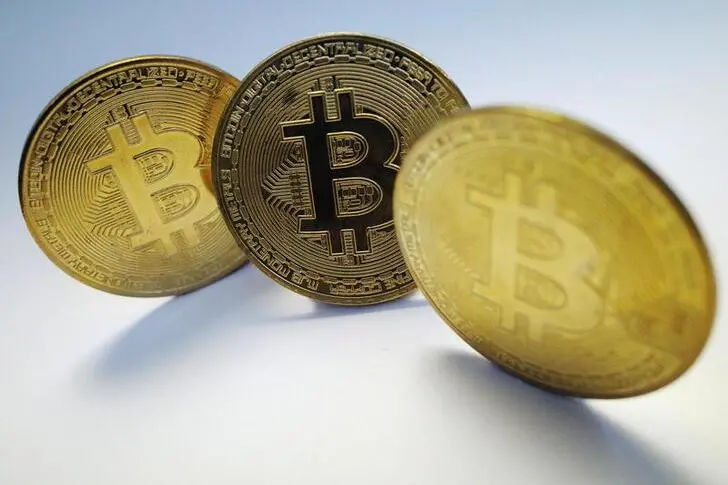PHOTO
ORLANDO, Fla.- With annual U.S. inflation running at its highest since 1982, now would be the perfect time for Bitcoin to stand up and cement its status as a 'real' asset, a store of value and the hedge against inflation its enthusiasts claim.
Many market the primary cryptocurrency as 'digital gold' - due largely to a design that limits its supply akin to the finite reserves of precious metal. And inflows into crypto funds have accelerated in recent months as investors - and notably, policymakers - fret about entrenched inflation.
But even if you set aside other defining issues like patchy liquidity or regulatory risks, Bitcoin now faces a twin challenge of higher real-world interest rates, perhaps rising more quickly than previously thought, and ever more volatility in a jumpier financial market getting used to ebbing credit.
For those with the stomach for it, volatility is one of Bitcoin's biggest appeals. It is what drives the intense price swings which, if timed right, can deliver spectacular returns. Monthly gains of 30% or more have been common this year - but these are pock-marked with drawdowns of 15% to 30% too.
Compared to gold, the world's oldest and most-established inflation hedge, Bitcoin is far more volatile. Inherently risk-averse investors seeking a relatively safe asset to hedge against rising inflation would at balk that level of volatility in their portfolios.
Three-month realized volatility for gold is around 13%, more or less where it was in early 2017 when the Fed started its last rate-hiking cycle. In May this year it reached an eight-year high of 22%.
Bitcoin's three-month realized volatility is around five times higher than gold's. It is currently 57%, also similar to where it was at the start of the Fed's 2017-18 cycle, and peaked at 110% earlier this year.
Unlike gold, however, it rose well into the second half of that two-year tightening cycle, peaking just above 110% in March 2018.
Two major shakeouts this year underscore the risks. Bitcoin plunged 50% over a nine-day period in May, and tumbled another 40% over a few weeks from its all-time high near $70,000 struck on Nov. 10.
According to analysts at UBS, this illustrates why digital gold is nowhere near as viable a hedge against inflation as actual gold. They also note that Bitcoin is far less resilient to equity market drawdowns than gold, another black mark against it as a hedge.
"We view direct exposure in crypto coins and tokens as suitable only for highly risk tolerant and speculative investors, and don't think they belong within a traditional financial portfolio," they wrote this week.
JP Morgan's Nikolaos Panigirtzoglou, however, argues that volatility is not inconsistent with being a store of value, as shown by gold's performance in the late 1970s and early 1980s. But it is worth paying close attention to.
The difference between realized Bitcoin vol and gold vol is a key determinant of Bitcoin's fair value in his framework. When the gap narrows, as it did in mid-2020 to around 2-to-1, Bitcoin's fair value was around $70,000. A gap now of around 5-to-1 suggests fair value could be less than half that, closer to $30,000.
"Bitcoin is already part of an investor's portfolio, it is already an institutional asset class. And it will only grow," he says.
But rising volume doesn't mean rising price. Look at the global FX market, whose average daily turnover has more than trebled in the last 20 years to $6 trillion. The dollar hasn't trebled in value.
REAL YIELDS
But what of inflation, traditional interest rates and the cost of money U.S. inflation rose at an annual pace of 6.8% in November, the fastest since 1982. Data from fund flows analysis firm EPFR suggests rising inflation concerns in recent months have stoked demand for Bitcoin and other cryptocurrencies.
Unsurprisingly, expectations on the Fed's policy response are also shifting. Futures markets now expect the Fed to start raising rates in June - perhaps even earlier - and three hikes of 25 basis points next year are almost fully discounted.
All else being equal, rising rates - especially real rates - rein in inflation expectations and are negative for both inflation hedges and commodity-like tokens such as Bitcoin that have no fixed yield to match.
Real yields have been negative for two years and reached a record low of -1.2% last month. But they may now have troughed and could well climb from here if the Fed follows its hawkish bark with a hawkish bite next year.
This hinges on how inflation behaves in the coming months, of course. The latest numbers show that price pressures are broadening.
So the big problem for Bitcoin is if the Fed feels it has to catch up and raise rates more aggressively. This could lift real yields closer to - maybe even into - positive territory, undermine risk appetite everywhere and potentially crush any inflation-driven support for 'new money.'
Few dare forecast Bitcoin's direction after the past five years of eye-watering gains and withering slides - but it will hardly be a refuge for the risk averse in another market storm.
(By Jamie McGeever; Editing by Andrea Ricci) ((jamie.mcgeever@thomsonreuters.com; +1 (407) 288-5607; Reuters Messaging: jamie.mcgeever.reuters.com@reuters.net))












